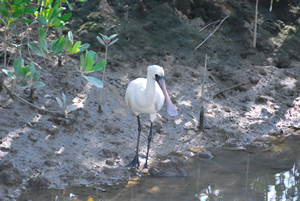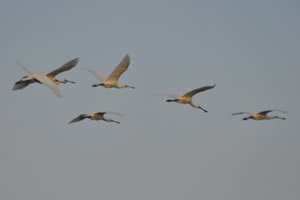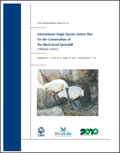
TOP > 生物多様性センターの国際協力 > ESABII > Database > Others > Black-Faced Spoonbill

Black-Faced Spoonbill

The conservation of the Black-faced Spoonbill is surely an example of a remarkable conservation success story.
In the early 1990s, the Black-faced Spoonbill numbered a few hundred and was known as one of the most threatened species of water birds. As a result of various conservation efforts, the population of this species increased to more than 2,000 by the late 2000s. It is also a species that brings organizations and people from all North East Asian countries together to establish a strong regional conservation network. ?Even though the population of the Black-faced Spoonbill is gradually recovering, it is still a globally endangered species with vulnerable breeding colonies and deteriorating wintering sites.
TAXONOMY
- Black-faced Spoonbill:Platalea minor (Temminck & Schlegel, 1849)
HABITAT

Black-faced Spoonbill uses coastal inter-tidal habitats, which are facing considerable threats from reclamation and pollution in eastern Asia. Theybreed on islets off the west coast of North Korea and South Korea, and Liaoning province in mainland China. This species has been reported in the Tumen river estuary of Russia and breeding was recorded in South Primorye for the first time in 2006. The three major wintering sites are the Tsengwen estuary of Taiwan, the Deep Bay area of Hong Kong (China), and the Chinese mainland and Hainan Island. It also winters in Cheju, South Korea, Kyushu and Okinawa, Japan, and the Red River delta, Vietnam, and there are recent records from Thailand, the Philippines, Macau (China) and inland China. The key known stopover sites used during migration include Yueqing Bay, Wenzhou Bay and Sanmen Bay, as well as Chongming Dongtian, Shanghai.
POPULATION
A recent study infers a historical population of about 10,300 individuals (Yeung et al. 2006), which fell to an estimated low of 288 individuals in 1988 but it appears to have recovered subsequently with a total of 1,679 individuals counted during the 2006 International Black-faced Spoonbill Census. The 2007, 2008, 2009 and 2010 censuses recorded totals of 1,695, 2,065, 2,041 and 2,347 birds, respectively, and a new high was recorded during the 2012 census, with a total of 2,693 individuals, representing a steady increase on previous totals that may reflect genuine increases and result from successful conservation measures at a number of sites.
Their population increased and has been steady recently. However, habitat destruction is still probably the biggest threat to this species. The main wintering grounds are threatened by industrial development, particularly at key sites in Taiwan and China, and by reclamation, especially in South Korea, Japan and China. In addition, pollution is the one of the major threats to birds wintering in Hong Kong, increasing levels of disturbance by fishers and tourists and also hunting are threats in China and Vietnam.
INTERNATIONAL CONSERVATION
The first action plan was published in 1995 and workshops involving all major range countries were held in 1996 and 1997. By the end of the 1990s, the Black-faced Spoonbill had become one of the best known conservation stories in eastern Asia.
The Black-faced Spoonbill was added to Appendix I of the Convention on Migratory Species (CMS) in 2002, and the CMS has supported the preparation of this second Black-faced Spoonbill Action Plan. In January 2006, the International Symposium on Research and Conservation of the Black-faced Spoonbill was held in Hong Kong (HKBWS 2007). In May 2007, the Macao Ecological Society held the 2007 Macao International Symposium on the Black-faced Spoonbill with the themes of urban development and wetland protection (Choi 2007). A second single species action plan was published in 2010.
At the same time, educational materials, satellite tracking and field survey results and management recommendations have been produced. Annual censuses have been conducted in recent years.
For more Information Click HERE!
Several Ramsar Sites, such as the Xuan Thuy Natural Wetland Reserve (Vietnam, designated in 1989), Dongzhaigang (China, 1992), Mai Po Marshes and Inner Deep Bay (Hong Kong, 1995), Manko (Japan, 1999), Yancheng National Nature Reserve (China, 2002), Chongming Dongtan Nature Reserve (China, 2002), Shankou Mangrove Nature Reserve (China, 2002) and Suncheon Bay (South Korea, 2006) are major habitats for this species.
For more Information about the Ramsar Convention on Wetland, Click HERE
DOMESTIC CONSERVATION
It is legally protected in China (including Hong Kong), Taiwan, North Korea, South Korea and Japan. Breeding sites in North Korea, at Taegam-do, Unmu-do, Sonchonrap-do and Tok-do, are designated as seabird sanctuaries and sites in China have been declared as non-hunting areas. Protected wintering sites include the Tainan National Park (Taiwan), Mai Po and Inner Deep Bay (Hong Kong), Xuan Thuy and Tien Hai (Vietnam), and Manko (Japan).
CHINA
The Black-faced Spoonbill has been listed as a Nationally Protected Species (Second Class) since 1989. Xingrentuo, the first breeding island found in China, is inside the Zhuanghe Shicheng Nature Reserve (Liaoning Province). The following are important migratory staging grounds and national or provincial nature reserves: the Yellow River Delta (Shandong Province), Yancheng Jiuduansha (Shanghai Municipality), Min Jiang Estuary, Quanzhou Wan (Fujian Province), Gongping Dahu, Futian (Guangdong Province), Beilun Estuary, Shankou (Guangxi Zhuang Autonomous Region) and Dongzhaigang (Hainan Province).
TAIWAN
The Black-faced Spoonbill was listed as a Class I (highest priority) protected species on 23 December 1995. Under the Wildlife Conservation Act, 300 hectares of the most important wintering habitat of the Black-faced Spoonbill at Tainan was protected as the “Tainan County Tsengwen Estuary 6 north bank Black-faced Spoonbill Protection Area” on 1 November 2002. On 28 December 2009, the Taijiang National Park (39,310 hectares) was established in Tainan. A protected area in the Tsengwen Estuary was included in this newly established national park.
HONG KONG
The Black-faced Spoonbill is protected by the Wild Animals Protection Ordinance, Chapter 170, Laws of Hong Kong. The core wintering habitats of the Black-faced Spoonbill are located within the Mai Po ? Inner Deep Bay Ramsar Site (designated in 1995). Mai Po Nature Reserve is managed by the World Wide Fund For Nature Hong Kong and the overall conservation management of the Ramsar Site is overseen by the Agriculture, Fisheries and Conservation Department (AFCD).
MACAO
The Black-faced Spoonbill is a protected species under the General Regulations for Common Areas enacted in 2005 to replace the former rules. In 2001, the Government of the Macao Special Administrative Region declared two nature reserves that support the species, a 15 hectare wetland site between Taipa and Coloane and a 40 hectare inter-tidal wetland that extends from the coastal wetland south of the Lotus Flower Bridge to the wetland north of Taipa.
NORTH KOREA
All species of birds (except some game species) are protected by law in North Korea, including the Black-faced Spoonbill. Four islands (Daegamdo, Sonchon Rabdo, Unmudo and Dokdo) that support important breeding populations of Black-faced Spoonbills have been designated as protected areas and Natural Monuments.
SOUTH KOREA
The Black-faced Spoonbill was designated as Natural Monument Number 205 on 30 May 1968 by the Cultural Heritage Administration. It is also listed as an endangered species (First level) by the Ministry of the Environment. The islets of Chilsando were designated as National Monument Number 389 in 1997 after the presence of breeding Black-faced Spoonbills was confirmed that summer. In 2000, the breeding grounds at Bido and the feeding areas at Ganghwa mudflat (total area 37,068ha) were designated as National Monument Number 419. The Ramsar Sites Suncheon Bay (designated in 2006) and Muan Tidal Flat (designated in 2008), were noted for their importance to the Black-faced Spoonbill.
JAPAN
The Black-faced Spoonbill is protected under the Wildlife Protection and Hunting Law (1919, last amended in 2005) as are most non-game species. It is also listed as category IA (critically endangered) on the Red List of Japan. This means that its conservation importance is recognized and it can be used a reference species in environmental impact assessment for development projects. Important wintering sites are protected by the Natural Parks Law (1957, last amended in 2006), Wildlife Protection and Hunting Law and Law for the Protection of Cultural Properties (1950, last amended in 2006). Mankoin Okinawa Prefecture and Wajiro Tidal Flat (Higata) in Fukuoka Prefecture have been designated as protected areas and the designation of Ariake-kai (Fukuoka and Saga prefectures) as a protected area is under consideration. Manko was designated as a Ramsar Site in 1999.
Conservation Activitres of the Wildbird Society of Japan, Click HERE (Japanese only)
VIETNAM
The Black-faced Spoonbill is listed as an IB species, meaning that it is strictly protected from exploitation and trading by Decision No. 48-2002/ND-CP dated 22 April 2002. It is also ranked in the Red Data Book of Vietnam as Endangered. Two protected areas have been designated for the Black-faced Spoonbill: Xuan Thuy National Park and Tien Hai Nature Reserve. Xuan Thuy was designated as a Ramsar Site in 1989.

